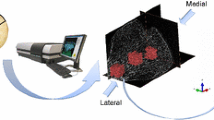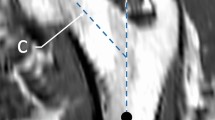Abstract
Summary
We examined the contributions of femoral neck cortical and trabecular bone to proximal femur failure load. We found that trabecular bone mineral density explained a significant proportion of variance in failure load after accounting for total bone size and cortical bone mineral content or cortical area.
Introduction
The relative contribution of femoral neck trabecular and cortical bone to proximal femur failure load is unclear.
Objectives
Our primary objective was to determine whether trabecular bone mineral density (TbBMD) contributes to proximal femur failure load after accounting for total bone size and cortical bone content. Our secondary objective was to describe regional differences in the relationship among cortical bone, trabecular bone, and failure load within a cross-section of the femoral neck.
Materials and methods
We imaged 36 human cadaveric proximal femora using quantitative computed tomography (QCT). We report total bone area (ToA), cortical area (CoA), cortical bone mineral content (CoBMC), and TbBMD measured in the femoral neck cross-section and eight 45° regions. The femora were loaded to failure.
Results and observations
Trabecular bone mineral density explained a significant proportion of variance in failure load after accounting for ToA and then either CoBMC or CoA respectively. CoBMC contributed significantly to failure load in all regions of the femoral neck except the posterior region. TbBMD contributed significantly to failure load in all regions of the femoral neck except the inferoanterior, superoposterior, and the posterior regions.
Conclusion
Both cortical and trabecular bone make significant contributions to failure load in ex vivo measures of bone strength.




Similar content being viewed by others
Notes
34 of these specimens were included in a previous study [10].
References
Cummings SR, Melton LJ (2002) Epidemiology and outcomes of osteoporotic fractures. Lancet 359:1761–1767
Johnell O, Kanis JA (2004) An estimate of the worldwide prevalence, mortality and disability associated with hip fracture. Osteoporos Int 15:897–902
Bousson V, Le Bras A, Roqueplan F et al (2006) Volumetric quantitative computed tomography of the proximal femur: relationships linking geometric and densitometric variables to bone strength. Role for compact bone. Osteoporos Int 17:855–864
Lang TF, Keyak JH, Heitz MW et al (1997) Volumetric quantitative computed tomography of the proximal femur: precision and relation to bone strength. Bone 21:101–108
Mayhew PM, Thomas CD, Clement JG et al (2005) Relation between age, femoral neck cortical stability, and hip fracture risk. Lancet 366:129–135
Turner CH (2005) The biomechanics of hip fracture. Lancet 366:98
Bouxsein ML, Fajardo RJ (2005) Cortical stability of the femoral neck and hip fracture risk. Lancet 366:1523–1524
Lotz JC, Cheal EJ, Hayes WC (1995) Stress distributions within the proximal femur during gait and falls: implications for osteoporotic fracture. Osteoporos Int 5:252–261
Bell KL, Loveridge N, Power J et al (1999) Structure of the femoral neck in hip fracture: cortical bone loss in the inferoanterior to superoposterior axis. J Bone Miner Res 14:111–119
Manske SL, Liu-Ambrose T, de Bakker PM et al (2006) Femoral neck cortical geometry measured with magnetic resonance imaging is associated with proximal femur strength. Osteoporos Int 17:1539–1545
Crabtree N, Loveridge N, Parker M et al (2001) Intracapsular hip fracture and the region-specific loss of cortical bone: analysis by peripheral quantitative computed tomography. J Bone Miner Res 16:1318–1328
Kuiper JW, Van Kuijk C, Grashuis JL (1997) Distribution of trabecular and cortical bone related to geometry. A quantitative computed tomography study of the femoral neck. Invest Radiol 32:83–89
Hologic. Hologic QDR 4500 User’s Guide. Hologic, Inc, Waltham, MA
Courtney AC, Wachtel EF, Myers ER, Hayes WC (1995) Age-related reductions in the strength of the femur tested in a fall-loading configuration. J Bone Joint Surg 77:387–395
Lochmüller EM, Groll O, Kuhn V, Eckstein F (2002) Mechanical strength of the proximal femur as predicted from geometric and densitometric bone properties at the lower limb versus the distal radius. Bone 30:207–216
Lochmüller EM, Muller R, Kuhn V, Lill CA, Eckstein F (2003) Can novel clinical densitometric techniques replace or improve DXA in predicting bone strength in osteoporosis at the hip and other skeletal sites? J Bone Miner Res 18:906–912
Eckstein F, Wunderer C, Boehm H et al (2004) Reproducibility and side differences of mechanical tests for determining the structural strength of the proximal femur. J Bone Miner Res 19:379–385
Pinilla TP, Boardman KC, Bouxsein ML, Myers ER, Hayes WC (1996) Impact direction from a fall influences the failure load of the proximal femur as much as age-related bone loss. Calcif Tissue Int 58:231–235
Robinovitch SN, Hayes WC, McMahon TA (1991) Prediction of femoral impact forces in falls on the hip. J Biomech Eng 113:366–374
Robinovitch SN, Hayes WC, McMahon TA (1995) Energy-shunting hip padding system attenuates femoral impact force in a simulated fall. J Biomech Eng 117:409–413
Zuckerman JD (1996) Hip fracture. N Engl J Med 334:1519–1525
Fox J (1991) Regression diagnostics. Sage, Newbury Park
Bell KL, Loveridge N, Power J, Garrahan N, Meggitt BF, Reeve J (1999) Regional differences in cortical porosity in the fractured femoral neck. Bone 24:57–64
Cooper DML, Thomas CDL, Clement JG, Turinsky AL, Sensen CW, Hallgrimsson B (2007) Age-dependent change in the 3D structure of cortical porosity at the human femoral midshaft. Bone 40:957–965
de Bakker PM, Manske SL, Ebacher V, Oxland TR, Guy P, Cripton PA. During sideways falls proximal femur fractures initiate in the superolateral cortex: evidence from high speed video of simulated fractures (in preparation)
Robinovitch SN, Hayes WC, McMahon TA (1997) Distribution of contact force during impact to the hip. Ann Biomed Eng 25:499–508
Sandler R, Robinovitch S (2001) An analysis of the effect of lower extremity strength on impact severity during a backward fall. J Biomech Eng 123:590–598
Bouxsein ML, Szulc P, Munoz F, Thrall E, Sornay-Rendu E, Delmas PD (2007) Contribution of trochanteric soft tissues to fall force estimates, the factor of risk, and prediction of hip fracture risk. J Bone Miner Res 22:825–831
Acknowledgements
We thank D. Malpas for QCT data acquisition, C. Tang and P.M. de Bakker for assistance with mechanical testing, as well as D. Liu for the histological sectioning. We would also like to acknowledge D. Thomas for his invaluable assistance in the development of the region-based analysis macro. This study was supported by an Establishment Grant from the Michael Smith Foundation for Health Research (MSFHR). S.L. Manske was supported by the Natural Sciences and Engineering Research Council (Canada), Alberta Heritage Foundation for Medical Research and MSFHR. T. Liu-Ambrose is an MSFHR Scholar. H.A. McKay is an MSFHR Senior Scholar.
Conflicts of interest
None.
Author information
Authors and Affiliations
Corresponding author
Rights and permissions
About this article
Cite this article
Manske, S.L., Liu-Ambrose, T., Cooper, D.M.L. et al. Cortical and trabecular bone in the femoral neck both contribute to proximal femur failure load prediction. Osteoporos Int 20, 445–453 (2009). https://doi.org/10.1007/s00198-008-0675-2
Received:
Accepted:
Published:
Issue Date:
DOI: https://doi.org/10.1007/s00198-008-0675-2




